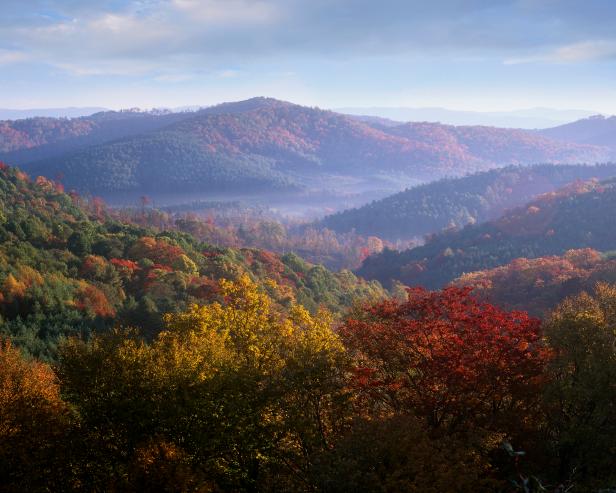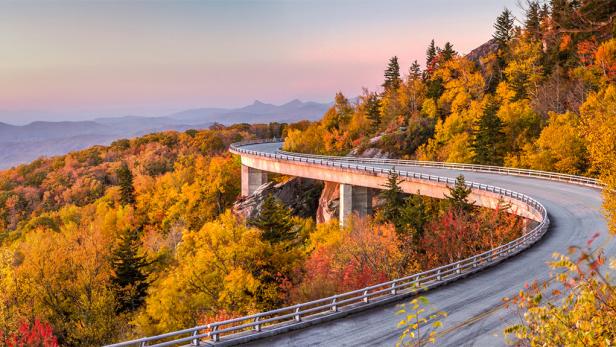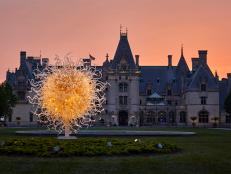Fall Escapes: Blue Ridge Parkway

Tim Fitzharris, Getty Images
Drivers have little choice but to take their time enjoying the serpentine Blue Ridge Parkway; the route's speed limit is a strictly enforced 45 mph, which at some points is lowered to a mere 25 mph.
But a slow pace is prime, especially during the fall, for enjoying one of the best-loved parkways in the United States. The Blue Ridge connects Shenandoah National Park in Virginia with the Great Smoky Mountains National Park in North Carolina.
When to Go
During October, the route's peak visiting month, drivers will be joined by plenty of other leaf-peepers, as thousands of visitors jam the highway (especially on weekends) to get a glimpse of the scarlet sourwoods, orange sassafras and golden poplars on display before a green canvas of southern Appalachian conifers.
The foliage-viewing season begins at the end of September, when the leaves of dogwood, sourwood and black gum trees turn deep red. Yellow poplars and hickories then burst into yellow, while maples bring red and sassafras turn orange. Finally, in late October, at the end of the season, oaks add a touch of brown and deeper reds.
Where to Drive
In early October, fall foliage is more impressive in the high mountains at the southern leg of the route than in the north. Visitors should start their journey in Virginia at Shenandoah National Park, milepost 0, near Waynesboro, Virginia. On the drive south, the panoramic views of the valleys on both sides of the parkway will amaze drivers as they traverse the twisting and curling section road. The views as well as the color get better as one approaches Pisgah and the Black Mountains in the south. The route concludes at the Great Smoky Mountains National Park near Cherokee, N.C., at milepost 469.
Drivers can park anywhere on the shoulder of the 469-mile road to enjoy the wealth of beauty and history of Virginia and North Carolina. However, they must follow National Park Service rules for the highway. These include no swimming in lakes or ponds, no hunting, no pets without a leash and no fires, except campground or picnic area fireplaces.

Moment / Getty Images
What to See and Do
An ideal beginning to a fall foliage road trip can be had at the Virginia Fall Foliage Festival in Waynesboro, at the start of the parkway. The event is held downtown, during the first two weekends in October. Besides checking out the arts and crafts on display at the festival, visitors to this quintessential small-town community can also explore Waynesboro's main street and historic district.
Take a quick photo-op side trip to the Linville Falls Visitor Center, between Linville and Marion, off route US 221. From the center, you can take a short hike to view the two mammoth waterfalls, upper at 12 feet and lower at 90 feet, as they plunge 2,000 feet into the Linville Gorge.
Glimpse early pioneer life at Mabry Mill, at milepost 176.2. The mill itself is the most photographed site on the entire parkway, and visitors can encounter the sawmill, blacksmith shop and a water-powered gristmill also on display.
An unexpected taste of European mountain culture can be found in Little Switzerland, N.C., at milepost 334, so named because the scenery surrounding this Appalachian Mountain town resembles that found in Switzerland. Here, visitors will find resorts and shops with a Swiss theme.
Tired of the sights above ground? At milepost 382, sightseers can trek 2,000 feet underground, into the Linville Caverns. Immediately beyond Linville, in Asheville, sits the Victorian childhood home and memorial to writer Thomas Wolfe. Fans of his work can see the inspiration for much of his writing. Also in town is the famed Biltmore Estate, an elegant chateau built in the French Renaissance style by George Washington Vanderbilt II.
History buffs will enjoy McCormick Farm in Steeles Tavern, Virginia. (Take a slight detour off the parkway, going west on state Route 56). Take a tour of the blacksmith shop, gristmill, museum and scenic site where the mechanized reaper, which triggered the Industrial Revolution, was invented.
At Crabtree Falls, 12 miles east of the parkway on state Route 56, you will find the largest vertical-drop waterfall east of the Mississippi. At the Rocky Knob Visitor Center, hike through wild apple orchards and the remains of stone chimneys, reminders that mountain families once inhabited the area.
Nearing the end of the parkway, make a detour to Waynesville, N.C., a mere 7 miles from the parkway. With any luck, your fall foliage viewing will coincide with the Haywood County Apple Harvest Festival, held during the third week of October. Celebrate the peak of the fall season by enjoying locally grown fresh and dried apples, apple cider, and arts and crafts; visitors can also square dance and listen to bluegrass bands.



























.jpg.rend.hgtvcom.231.174.suffix/1674758726773.jpeg)











